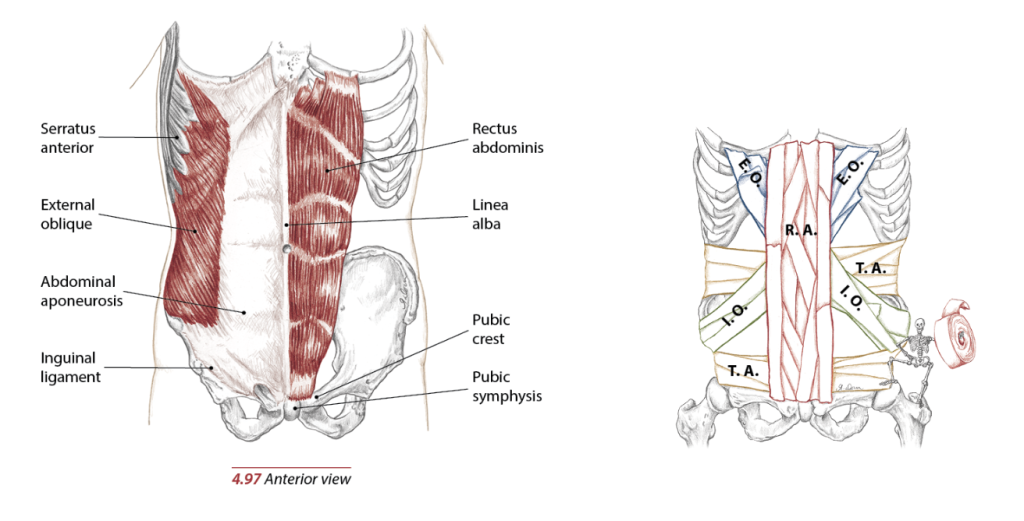Training core abdominal muscles is sometimes a straightforward goal for personal training clients, and other times – injuries and discomfort arise when crunching, planking and rotating the spine. Studying core anatomy closely helps certified personal trainers design exercises and make alterations accordingly when helping clients strengthen their core.
The term “core” is often used synonymously with abdominals. It is important to note that the core of the trunk includes other muscles like quadratus lumborum, latissimus dorsi, pyramidalis, multifidus, iliocostalis, longissimus, and serratus posterior. AND….Some people believe the pelvis is the core of the body.
In this article, we will explore the basics of the four main abdominal muscles as a part of the larger core.

Books of Discovery 2014
Four Core Abdominal Muscles
Above you can see how the core abdominal muscles criss-cross one another creating a blanket of stability around the torso. Below is a brief description of each core abdominal muscle that can be used for basic review and understanding. Click on each highlighted name below to be re-directed to an article that addresses the specifics of each muscle.
Rectus Abdominus
The rectus abdominus (RA) is often described as the six pack muscle. It is easily identified on an individual with a defined muscular tone. RA attaches superior to inferior on the anterior trunk. Its main role is in trunk and spine flexion, although it assists with side bending and rotation.
It is important to counteract RA flexion exercises with properly directed spinal extension, sidebend, and rotation.
Transverse Abdominus
The transverse abdominus (TVA) is like a corset or belt that wraps around the lower half of the spine. It hugs the lumbar vertebrae and stabilizes the lower trunk. Exercising the TVA often requires more skill and awareness than working the other muscles. Breathing is an important component to consider when strengthening any abdominal muscle, but especially the TVA.
External and Internal Oblique
The external and internal oblique cross over one another on the lateral anterior abdomen. They are often grouped together as one muscle called “obliques”. These two muscles are interesting mechanically because they both flex and side bend the spine. However, they each rotate the spine in an opposite direction. This means the right external oblique and left internal oblique contract together in spine rotation.
Unified Movement of the Core Abdominal Muscles
The core abdominal muscles flex, side bend, rotate, and compress the spine. Even though certain abdominal exercises are meant to target one or the other, these muscles truly work as a unit – all performing all three actions. The RA might be better at flexion then external oblique, but this is unique to the individual.
It may be impossible to isolate one of the four abdominal muscles from the others. Rather than trying to train each muscle individually, seek to train the various movements and combinations of movements when strengthening the core.
For example, exercise the anterior trunk and core by:
- Flexing only
- Flexing and side bending
- Flexing and rotating
- Flexing, side bending and rotating
- Side bending and rotating
- Side bending only
- Rotating only
Include a variety of isometric holds at various lengths of time, various combinations of repetitions. Tweaking the training tempo changes results. Performing both large powerful movements with the core and smaller more refined exercises is essential to maintain balance and stability within the system.
Strengthening the Core Abdominal Muscles
There are hundreds of exercises that work the core abdominals. You can strengthen them by crunching and flexing the spine or without. You can train them with rotation or without. You can train them by planking or not.
Many upper and lower body strengthening exercises work the core abdominals by nature. So does cardio. You can train the core abdominals with isometric exercise, or by using repetitions. Once again, variety in programming is the key to success.
How you train the core abdominal muscles depends on the client’s goals, health history, and current function. Training this area is a common ambition of fitness enthusiasts, but can lead to injury when not approached properly.
Examining each muscle, its attachments, function, specific needs for training and limitations is essential for optimal training and injury prevention.
Studying anatomy and the core abdominal muscles as a region can help you cue proper form and program for your clients. Advanced knowledge in anatomy sets you apart from other trainers and helps you get results more effectively.
Beverly Hosford, MA teaches anatomy and body awareness using a skeleton named Andy, balloons, play-doh, ribbons, guided visualizations, and corrective exercises. She is an instructor, author, and a business coach for fitness professionals. Learn how to help your clients sleep better with in Bev's NFPT Sleep Coach Program and dive deeper into anatomy in her NFPT Fundamentals of Anatomy Course.


